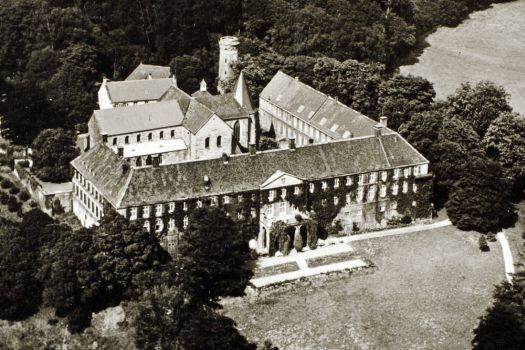
Ausbauphase kirchlicher Strukturen
In der Region des heutigen Ruhrgebiets kam es zu Neugründungen von Klöstern zisterziensischer und prämonstratensischer Prägung. Sie trugen zur Verbreitung der hochmittelalterlichen Kultur bei.
Die Prämonstratenser verbanden das kontemplative monastische Leben mit der nach außen gerichteten Seelsorge (vita mixta).
© LWL-AfDW Bildarchiv
Glaube zurück zur Auswahl
The development phase of ecclesiastical structures - Reform orders of the 12th century
The reform movement of the Benedictine monasticism in the 12th century was characterised by a withdrawal from worldly things and by the individual monk's personal poverty. Among other things, the ideology of hermithood carried over to entire, sometimes very large, monastic communities, which provided an ideal not only for subsidiary monasteries and the expansion of these orders, but also for late-medieval revival movements. In today's Ruhr Region, too, it led to the establishment of new monasteries of Cistercian and Premonstratensian character.
The Cîteaux monastery was founded by Robert von Molesme in 1098 in a secluded valley near Dijon. From the mother monastery, the Cistercians alone founded 109 filial establishments, among these the Kamp monastery in 1123 as the first of the order in Germany. By contrast, the Premonstratensian are canon's monasteries. The itinerant preacher Norbert von Xanten founded the order's first monastery on papal intervention in 1121 in Prémontré near Laon. Cappenberg, in 1122, was the third monastery of the order, even before it was fully established and recognised. The Premonstratensians combined the contemplative monastic life with outward directed pastoral care (vita mixta).
One special contribution by this order is the development of model farms with fruit growing and viniculture, and horse and fish farming (Kamp monastery). They promoted mining, the wool trade, and contributed to spreading medieval culture. The Gothic architectural style, adopted at first with hesitation, came to be spread throughout Germany not least through these orders. The reform orders of the 12th century could draw on the copious source of technologies developed in workshops of earlier monasteries. Like all monks, they too devoted themselves to the task of copying liturgical and theological manuscripts. Music for organising masses and canonical hours was also developed. The development of artisan craft too was promoted - among other things, the creation of liturgical equipment such as chalices, containers for relics, portable altars, book covers, and much more. In this context, the origin of outstanding pieces preserved in Cappenberg, such as the "Barbarossa head" and the christening bowl, has not been established.
The early churches of these orders mirror their ideals: clearly structured three-nave basilicas with a transept and choir, but no prominent western tower, with the Cistercians, fully vaulted, with somewhat more ornamentation and a row of chapels linked to the transept, with the Premonstratensians, mostly featuring a flat ceiling, virtually devoid of ornamentation, and with a simpler eastern structure. While only archaeological research can reveal hints as to the architectural form of the Cistercian church in Kamp, the Premonstratensian church of Cappenberg has received later modifications.
Denkmale zum Impuls
Selm - Prämonstratenserkloster Cappenberg
Gottfried von Cappenberg, Mitglied eines der mächtigsten Adelsgeschlechter in Westfalen, ... weiter
Kamp-Lindfort - Kloster Kamp
Im 12. Jahrhundert beabsichtigte Abt Robert, das Kloster Molesme im heutigen Departement ... weiter
